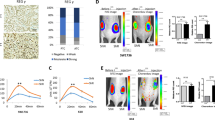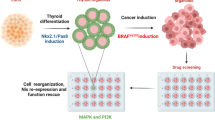Abstract
CD97, a member of the adhesion family of G-protein-coupled receptors (GPCRs), complexes with and potentiates lysophosphatidic acid (LPA) receptor signaling to the downstream effector RHOA. We show here that CD97 was expressed in a majority of thyroid cancers but not normal thyroid epithelium and that the level of CD97 expression was further elevated with progression to poorly differentiated and undifferentiated carcinoma. Intratumoral progression also showed that CD97 expression correlates with invasiveness and dedifferentiation. To determine the functional role of CD97, we produced a transgenic model of thyroglobulin promoter-driven CD97 expression. Transgenic CD97 in combination with ThrbPV, an established mouse model of thyroid follicular cell carcinogenesis, significantly increased the occurrence of vascular invasion and lung metastasis. Expression of transgenic CD97 in thyroid epithelium led to elevated ERK phosphorylation and increased numbers of Ki67+ cells in developing tumors. In addition, tumor cell cultures derived from CD97 transgenic as compared with non-transgenic mice demonstrated enhanced, constitutive and LPA-stimulated ERK activation. In human thyroid cancer cell lines, CD97 depletion reduced RHO-GTP and decreased LPA-stimulated invasion but not EGF-stimulated invasion, further suggesting that CD97 influences an LPA-associated mechanism of progression. Consistent with the above, CD97 expression in human thyroid cancers correlated with LPA receptor and markers of aggressiveness including Ki67 and pAKT. This study shows an autonomous effect of CD97 on thyroid cancer progression and supports the investigation of this GPCR as a therapeutic target for these cancers.
This is a preview of subscription content, access via your institution
Access options
Subscribe to this journal
Receive 50 print issues and online access
$259.00 per year
only $5.18 per issue
Buy this article
- Purchase on Springer Link
- Instant access to full article PDF
Prices may be subject to local taxes which are calculated during checkout









Similar content being viewed by others
References
Kondo T, Ezzat S, Asa SL . Pathogenetic mechanisms in thyroid follicular-cell neoplasia. Nat Rev Cancer 2006; 6: 292–306.
DeLellis R, Lloyd RV, Heitz P, Eng C . Pathology and genetics of tumors of endocrine organs. WHO classification of tumors. IARC, Lyonpress, 2004.
Garcia-Rostan G, Sobrinho-Simoes M . Poorly differentiated thryoid carcinoma: an evolving entity. Diagn Histopathol 2011; 17: 114–123.
Wiseman SM, Loree TR, Rigual NR, Hicks WL, Douglas WG, Anderson GR et al. Anaplastic transformation of thyroid cancer: review of clinical, pathologic, and molecular evidence provides new insights into disease biology and future therapy. Head Neck 2003; 25: 662–670.
Sipos JA, Mazzaferri EL . Thyroid cancer epidemiology and prognostic variables. Clin Oncol (R Coll Radiol) 2011; 22: 395–404.
Kojic SL, Strugnell SS, Wiseman SM . Anaplastic thyroid cancer: a comprehensive review of novel therapy. Expert Rev Anticancer Ther 2011; 11: 387–402.
Nagaiah G, Hossain A, Mooney CJ, Parmentier J, Remick SC . Anaplastic thyroid cancer: a review of epidemiology, pathogenesis, and treatment. J Oncol 2011 2011. 542358.
Gray JX, Haino M, Roth MJ, Maguire JE, Jensen PN, Yarme A et al. CD97 is a processed, seven-transmembrane, heterodimeric receptor associated with inflammation. J Immunol 1996; 157: 5438–5447.
Yona S, Lin HH, Siu WO, Gordon S, Stacey M . Adhesion-GPCRs: emerging roles for novel receptors. Trends Biochem Sci. 2008; 33: 491–500.
Aust G, Steinert M, Schutz A, Boltze C, Wahlbuhl M, Hamann J et al. CD97, but not its closely related EGF-TM7 family member EMR2, is expressed on gastric, pancreatic, and esophageal carcinomas. Am J Clin Pathol 2002; 118: 699–707.
Loberg RD, Wojno KJ, Day LL, Pienta KJ . Analysis of membrane-bound complement regulatory proteins in prostate cancer. Urology 2005; 66: 1321–1326.
Mustafa T, Eckert A, Klonisch T, Kehlen A, Maurer P, Klintschar M et al. Expression of the epidermal growth factor seven-transmembrane member CD97 correlates with grading and staging in human oral squamous cell carcinomas. Cancer Epidemiol Biomarkers Prev 2005; 14: 108–119.
Steinert M, Wobus M, Boltze C, Schutz A, Wahlbuhl M, Hamann J et al. Expression and regulation of CD97 in colorectal carcinoma cell lines and tumor tissues. Am J Pathol 2002; 161: 1657–1667.
Ward Y, Lake R, Yin JJ, Heger CD, Raffeld M, Goldsmith PK et al. LPA receptor heterodimerizes with CD97 to amplify LPA-initiated RHO-dependent signaling and invasion in prostate cancer cells. Cancer Res [Research Support, N.I.H., Intramural] 2011; 71: 7301–7311.
Lagerstrom MC, Schioth HB . Structural diversity of G protein-coupled receptors and significance for drug discovery. Nat Rev Drug Discov 2008; 7: 339–357.
Lin ME, Herr DR, Chun J . Lysophosphatidic acid (LPA) receptors: signaling properties and disease relevance. Prostaglandins Other Lipid Mediat 2010; 91: 130–138.
Stortelers C, Kerkhoven R, Moolenaar WH . Multiple actions of lysophosphatidic acid on fibroblasts revealed by transcriptional profiling. BMC Genomics 2008; 9: 387.
Jonkers J, Moolenaar WH . Mammary tumorigenesis through LPA receptor signaling. Cancer Cell 2009; 15: 457–459.
Meier CA, Parkison C, Chen A, Ashizawa K, Meier-Heusler SC, Muchmore P et al. Interaction of human beta 1 thyroid hormone receptor and its mutants with DNA and retinoid X receptor beta. T3 response element-dependent dominant negative potency. J Clin Invest 1993; 92: 1986–1993.
Kaneshige M, Kaneshige K, Zhu X, Dace A, Garrett L, Carter TA et al. Mice with a targeted mutation in the thyroid hormone beta receptor gene exhibit impaired growth and resistance to thyroid hormone. Proc Natl Acad Sci USA 2000; 97: 13209–13214.
Adeniran AJ, Zhu Z, Gandhi M, Steward DL, Fidler JP, Giordano TJ et al. Correlation between genetic alterations and microscopic features, clinical manifestations, and prognostic characteristics of thyroid papillary carcinomas. Am J Surg Pathol 2006; 30: 216–222.
Nikiforov YE . Molecular analysis of thyroid tumors. Mod Pathol 2011; 24 (Suppl 2): S34–S43.
Horak CE, Mendoza A, Vega-Valle E, Albaugh M, Graff-Cherry C, McDermott WG et al. Nm23-H1 suppresses metastasis by inhibiting expression of the lysophosphatidic acid receptor EDG2. Cancer Res [Research Support, N.I.H., Intramural] 2007; 67: 11751–11759.
Guo R, Kasbohm EA, Arora P . Sample CJ, Baban B, Sud N, et al. Expression and function of lysophosphatidic acid LPA1 receptor in prostate cancer cells. Endocrinology 2006; 147: 4883–4892.
Suzuki H, Willingham MC, Cheng SY . Mice with a mutation in the thyroid hormone receptor beta gene spontaneously develop thyroid carcinoma: a mouse model of thyroid carcinogenesis. Thyroid 2002; 12: 963–969.
Ying H, Suzuki H, Furumoto H, Walker R, Meltzer P, Willingham MC et al. Alterations in genomic profiles during tumor progression in a mouse model of follicular thyroid carcinoma. Carcinogenesis 2003; 24: 1467–1479.
Kjellman P, Wallin G, Hoog A, Auer G, Larsson C, Zedenius J . MIB-1 index in thyroid tumors: a predictor of the clinical course in papillary thyroid carcinoma. Thyroid 2003; 13: 371–380.
Lu C, Zhu X, Willingham MC, Cheng SY . Activation of tumor cell proliferation by thyroid hormone in a mouse model of follicular thyroid carcinoma. Oncogene 2011; Sep: 12.
Saji M, Narahara K, McCarty SK, Vasko VV, La Perle KM, Porter K et al. Akt1 deficiency delays tumor progression, vascular invasion, and distant metastasis in a murine model of thyroid cancer. Oncogene 2011; 30: 4307–4315.
Lin S, Wang D, Iyer S, Ghaleb AM, Shim H, Yang VW et al. The absence of LPA2 attenuates tumor formation in an experimental model of colitis-associated cancer. Gastroenterology 2009; 136: 1711–1720.
Liu S, Umezu-Goto M, Murph M, Lu Y, Liu W, Zhang F et al. Expression of autotaxin and lysophosphatidic acid receptors increases mammary tumorigenesis, invasion, and metastases. Cancer Cell 2009; 15: 539–550.
Kehlen A, Englert N, Seifert A, Klonisch T, Dralle H, Langner J et al. Expression, regulation and function of autotaxin in thyroid carcinomas. Int J Cancer 2004; 109: 833–838.
Gupte R, Patil R, Liu J, Wang Y, Lee SC, Fujiwara Y et al. Benzyl and naphthalene methylphosphonic acid inhibitors of autotaxin with anti-invasive and anti-metastatic activity. ChemMedChem 2011; 6: 922–935.
Acknowledgements
This work was supported by the Intramural Research Program, Center for Cancer Research, National Cancer Institute and the Programa Ramón y Cajal—Ministerio de Ciencia e Innovación, Social EU Funds, Universidad de Valladolid, Spain. We acknowledge Barbara J Taylor, Subhadra Banerjee, William G Telford, and Veena Kapoor of the CCR FACS Core Facilities and Christopher D Heger of the CCR Antibody and Protein Purification Unit for their excellent technical support. We thank Drs Cameselle–Teijeiro, X Matías–Guiu, A Herrero and M Fresno–Forcelledo for providing human PDC and UC samples.
Author information
Authors and Affiliations
Corresponding author
Ethics declarations
Competing interests
The authors declare no conflict of interest.
Additional information
Supplementary Information accompanies the paper on the Oncogene website
Supplementary information
Rights and permissions
About this article
Cite this article
Ward, Y., Lake, R., Martin, P. et al. CD97 amplifies LPA receptor signaling and promotes thyroid cancer progression in a mouse model. Oncogene 32, 2726–2738 (2013). https://doi.org/10.1038/onc.2012.301
Received:
Revised:
Accepted:
Published:
Issue Date:
DOI: https://doi.org/10.1038/onc.2012.301
Keywords
This article is cited by
-
LPA1-mediated inhibition of CXCR4 attenuates CXCL12-induced signaling and cell migration
Cell Communication and Signaling (2023)
-
CD97 negatively regulates the innate immune response against RNA viruses by promoting RNF125-mediated RIG-I degradation
Cellular & Molecular Immunology (2023)
-
CD97 serves as a novel biomarker of immune cell infiltration in hepatocellular carcinoma
World Journal of Surgical Oncology (2022)
-
CD97 is associated with mitogenic pathway activation, metabolic reprogramming, and immune microenvironment changes in glioblastoma
Scientific Reports (2022)
-
Genetic manipulation of adhesion GPCR CD97/ADGRE5 modulates invasion in patient-derived glioma stem cells
Journal of Neuro-Oncology (2021)



